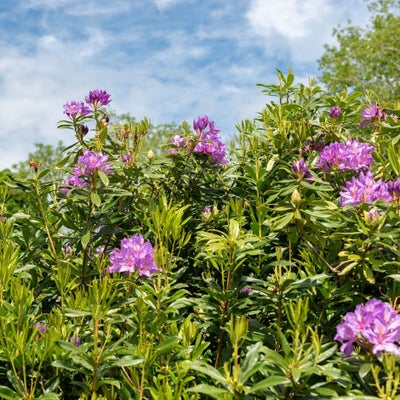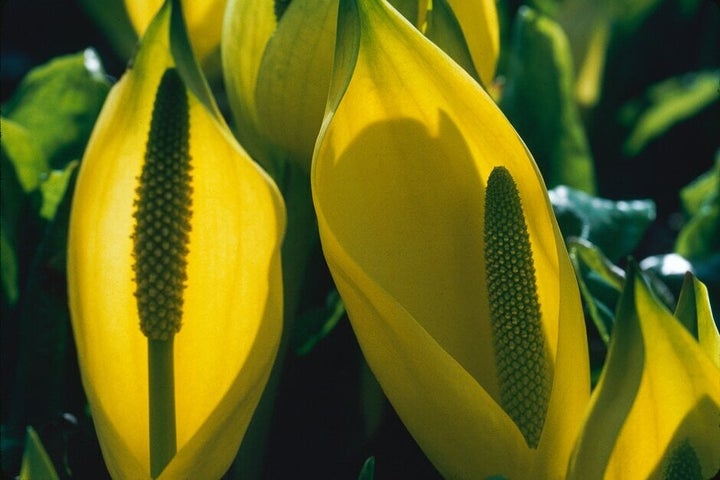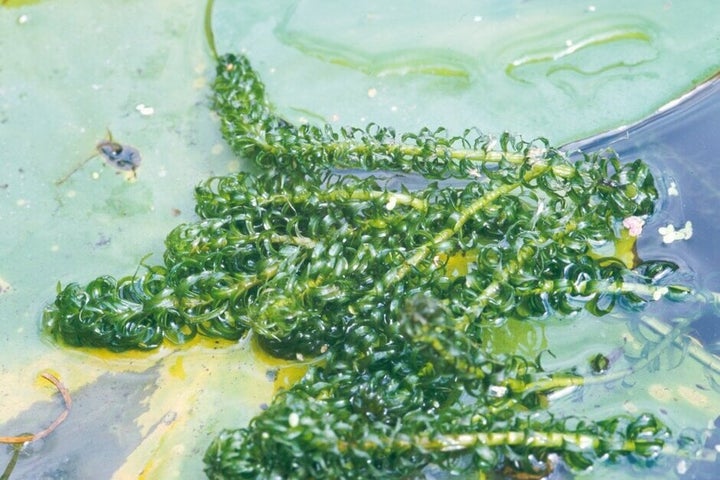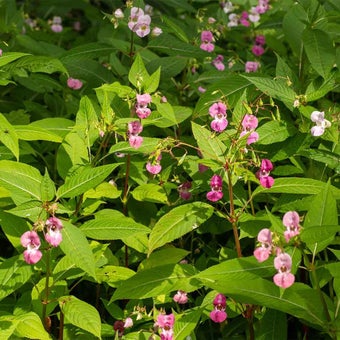
Quick facts
Invasive non-native plants threaten biodiversity, the economy and human health
Identification of plants is key. Many invasive species can be confused with non-invasive plants
Gardeners can help control the spread of invasive plant species by managing and disposing of plants properly
Some invasive plants can’t be grown, cared for, sold and transported by law
There are numerous layers of legislation that apply to invasive non-native species, so check the individual species carefully for details
What are non-native invasive plants?
Non- plants are those that occur outside their natural range (where they originate from) due to direct or indirect introduction by humans. When these introduced plants grow and become established in natural or unmanaged habitats, they are termed ‘ ’.
Many naturalised species do not present a problem but, those that spread and outcompete native species, can threaten habitats and ecosystems. Only where this occurs are the plants termed ‘ non-native species’. They are considered to be invasive either due to a lack of natural control mechanisms (such as herbivores); rapid rate of spread (by seed or vegetatively) or suppression of other species (such as allelopathy or competition for resources).
Non-native invasive plants can:
- Change habitats and ecosystems and have non-biotic effects, such as reducing or impeding water flow leading to flooding, or changing the soil environment, such as soil , chemical composition or nutrient availability.
- Outcompete native plants either by habitat change or by spreading so rapidly as to crowd out slower growing species, threatening their long-term survival.
- Take a long time to become invasive. Many of the plants now considered invasive have been growing in the UK for over 100 years and, for much of that time, showed no sign of becoming a problem.
- Be expensive to eradicate. It is also very costly to restore degraded habitat, if it can be done at all.


Did you know?
Just under eight percent of introduced species are estimated to have a negative impact in the UK. The BSBI (Botanical Society of Britain and Ireland) recorded 3,445 plant species in Britain in their Plant Atlas 2020 – 1,692 are native species and 1,753 are introduced.
Invasive plants covered by legislation
There are different regulations to help protect the UK from non- plants.
In Scotland, the Wildlife and Natural Environment Act (Scotland) 2011, makes it illegal to plant any non-native plant in the wild in Scotland.
Elsewhere in the UK it is an offence to plant or cause to grow in the wild plants listed on Schedule 9 of the Wildlife and Countryside Act (1981). In April 2014, a ban on the sale of seven of the worst invasive water plants in the UK came into force (see list below).
EU Regulation 1143/2014 on invasive alien species was retained in UK law after Brexit. England and Wales, Northern Ireland, and Scotland kept the Regulation’s list of invasive alien species, and these species should not be planted or caused to grow in the wild. Additionally, under this legislation they are banned from sale and gardeners possessing them should undertake measures to control them.
The EU list forms the basis for the Non-Native Species Secretariat (NNSS) Species of Special Concern list which applies across Great Britain; this may diverge from the EU list over time, as plants are reviewed and added or de-listed accordingly.
Below is a list of invasive non-native plants covered by regulation:
S – applies in Scotland: all the plants listed below are illegal to plant in the wild, but check for the addition of EU as this indicates they are also banned from sale and should be controlled.
EU – applies across the EU, including the UK and Republic of Ireland: it is an offence to plant or cause these to grow in the wild. These are also banned from sale and gardeners possessing them should undertake measures to control them.
EW– applies in England and Wales: it is an offence to plant or cause these to grow in the wild.
NI– applies in Northern Ireland: it is an offence to plant or cause these to grow in the wild.
RI– applies in the Republic of Ireland: it is an offence to plant or cause these to grow in the wild.
Acacia saligna (golden wreath wattle) S, EU
Acaena spp. (pirri-pirri bur) S, NI
Ailanthus altissima (tree of heaven) S, EU
Allium paradoxum (few-flowered leek) S, EW, NI
Allium triquetrum (three-cornered garlic) S, EW, RI
Alternanthera philoxeroides (alligator weed) S, EU
Andropogon virginicus (broomsedge) S, EU
Aponogeton distachyos (Cape pondweed) S, RI
Arundo donax (giant reed) S, NI
Asclepias syriaca (milkweed) S, EU
Azolla filiculoides (water fern) S, EW, NI, RI,banned from sale in UK since 2014
Baccharis halimifolia (tree groundsel) S, EU
Cabomba caroliniana (Carolina fanwort, Carolina water shield) S, EU
Cardiospermum grandiflorum (balloon vine) S, EU
Carpobrotus edulis (Hottentot fig) S, EW, NI, RI
Cortaderia jubata (purple pampas grass) S, EU
Cotoneaster bullatus (cotoneaster, hollyberry) S, EW
Cotoneaster horizontalis (cotoneaster) S, EW
Cotoneaster integrifolius (entire-leaved cotoneaster) S, EW
Cotoneaster microphyllus (small-leaved cotoneaster) S, EW
Cotoneaster simonsii (Himalayan cotoneaster) S, EW
Crassula helmsii (Australian swamp stonecrop, New Zealand pygmyweed) S, EW, NI, RI,banned from sale in UK since 2014
Crocosmia × crocosmiiflora (montbretia) S, EW
Disphyma crassifolium (purple dewplant) S, EW
Egeria densa (large flowered waterweed) S, NI, RI
Ehrharta calycina (purple veldtgrass) S, EU
Eichhornia crassipes (water hyacinth) S, EU
Elodea nuttallii (Nuttall’s waterweed) S, EU
Elodea spp. (waterweeds) S, EW, NI, RI
Fallopia japonica (RHS accepted name Reynoutria japonica) (Japanese knotweed) S, EW, NI, RI
Fallopia japonica × Fallopia sachalinensis [F. × bohemica] (RHS accepted name Reynoutria × bohemica) ( knotweed) S, EW, NI, RI
Fallopia sachalinensis (RHS accepted name Reynoutria sachalinensis) (giant knotweed) S, EW, NI, RI
Gunnera manicata (Brazilian giant rhubarb) S, RI
Gunnera tinctoria (Chilian rhubarb, giant rhubarb) S, EU
Gymnocoronis spilanthoides (Senegal tea) S, EU
Heracleum mantegazzianum (giant hogweed) S, EU
Heracleum persicum (Persian hogweed, Tromsø palm) S, EU
Heracleum sosnowskyi (Sosnowsky's hogweed) S, EU
Hippophae rhamnoides (sea buckthorn) S, NI, RI
Humulus scandens (Japanese hop) S, EU
Hyacinthoides hispanica (Spanish bluebell) S, NI, RI
Hydrocotyle ranunculoides (floating pennywort) S, EU, banned from sale in UK since 2014
Impatiens glandulifera (Himalayan balsam) S, EU
Juncus planifolius (broad-leaved rush) S, RI
Lagarosiphon major (curly waterweed) S, EU
Lamiastrum galeobdolon subsp. argentatum (RHS accepted name Lamium galeobdolon 'Florentinum') ( yellow archangel) S, EW
Lespedeza cuneata (Chinese shrub clover) S, EU
Lonicera japonica (Japanese honeysuckle) S, NI
Ludwigia grandiflora (water primrose) S, EU, banned from sale in UK since 2014
Ludwigia peploides (creeping water primrose, floating water primrose) S, EU, banned from sale in UK since 2014
Ludwigia uruguayensis (syn. Ludwigia grandiflora subsp. hexapetala) (water primrose) S, EW, NI, RI, banned from sale in UK since 2014
Lygodium japonicum (climbing fern) S, EU
Lysichiton americanus (yellow skunk cabbage) S, EU
Microstegium vimineum (Japanese stiltgrass) S, EU
Myriophyllum aquaticum (parrot’s feather) S, EU, banned from sale in UK since 2014
Myriophyllum heterophyllum (broadleaf watermilfoil) S, EU
Nymphoides peltata (fringed waterlily) S, NI, RI
Parthenium hysterophorus (parthenium weed) S, EU
Parthenocissus inserta (false Virginia creeper) S, EW
Parthenocissus quinquefolia (Virginia creeper) S, EW
Pennisetum setaceum (crimson fountain grass) S, EU
Persicaria wallichii (RHS accepted name Koenigia polystachya) (Himalayan knotweed) S, NI, RI
Pistia stratiotes (water lettuce) S, EW, NI, RI
Polygonum perfoliatum (RHS accepted name Persicaria perfoliata) (mile-a-minute weed) S, EU
Prosopis juliflora (mesquite) S, EU
Pueraria montana var. lobata (kudzu) S, EU
Rhododendron luteum (yellow azalea) S, EW
Rhododendron ponticum (rhododendron) S, EW, RI
Rhododendron ponticum × Rhododendron maximum (rhododendron) S, EW, RI
Rosa rugosa (Japanese rose) S, EW
Rubus spectabilis (salmonberry) S, NI, RI
Sagittaria latifolia (duck potato) S, EW
Salvinia molesta (giant salvinia) S, EU
Smyrnium perfoliatum (perfoliate Alexanders) S, EW
Spartina spp. and hybrids (cord-grasses) S, NI, RI
Stratiotes aloides (water soldier) S, NI
Trapa natans (water chestnut) S, NI, RI
Triadica sebifera (Chinese tallow tree) S, EU
Zostera japonica (dwarf eelgrass) S, NI, RI
Controlling invasive non-native plants
What if I have invasive non-native plants in my garden or on my land?
If you already have these species in your garden or on your land, you are not likely to be prosecuted simply for having them. However it is good practice, which we recommend, to remove and destroy them where possible, even if you didn’t plant them. It is also your responsibility to ensure that they are not allowed to spread.
Most of the non-aquatic non- plants can be suppressed using non-chemical control methods. If you have a very large area to treat it may be best to obtain the services of a contractor with the appropriate Certificate of Competence or a firm who specialise in the control of weeds such as Japanese knotweed. The organisations below have lists/registers of contractors who specialise in the removal of invasive non-native plants:
PCA (Property Care Association) Invasive Weed Control Group
Invasive Non-Native Specialists Association
The British Association of Landscape Industries (BALI)
Trustmark Government Endorsed Standards
Aquatic weeds can be pulled out of ponds or streams by hand. Where spraying might be an option in areas adjacent to, or over, water bodies, consult with the Environment Agency who can supply a list of fully trained contractors. Do not use home weedkillers on or near water.


The RHS does not support the use of weedkillers and recommends that alternative control methods are used. However, when invasive plants are a threat to and gardeners struggle to control them with cultural methods, targeted use of legally-available, regulated weedkillers may be an option. Garden centres and large retailers selling weedkillers have trained staff who can advise on suitable products for your needs.
How should I dispose of these invasive weeds?
There is always a risk when disposing of invasive weeds that you may inadvertently spread them further. Here’s how to reduce that risk:
Aquatic weeds:
or bury aquatic weeds in trenches in the garden. When dried they may be burnt.
Himalayan balsam, giant hogweed and Japanese knotweed:
These weeds are regarded as 'controlled waste' under the Environmental Protection Act (Duty of Care) Regulations. If possible, destroy Himalayan balsam, giant hogweed and Japanese knotweed on site. If removal is necessary, the Environment Agency needs to be informed and you must use a registered waste carrier and an authorised disposal site. Contact the Environment Agency or your local council for information on authorised sites. If you use licensed contractors, ensure they use registered disposal sites and provide copies of waste transfer permits. Useful government websites are:
Treatment and disposal of invasive non-native plants: RPS 178
How to stop invasive non-native plants from spreading
How to stop Japanese knotweed from spreading

Do not put these weeds in your home compost, council or household waste bin
Other invasive plants on the EU list:
Destroy, bury or burn plant material on site if possible. Bear in mind home compost bins may not reach high enough temperatures to kill roots, stems and seeds of some plants. DEFRA advise they can be disposed of as normal green waste through local recycling.
Note that the movement of invasive non-native plants is only permitted as part of responsible disposal. Never dump invasive plants or any garden plant in the wild or at the side of the road.
What could happen if I don't control an invasive species on my land?
The UK Government introduced new provisions in the Infrastructure Act (2015) to control invasive non-native species in England and Wales. There are two levels of control: a species control agreement and a species control order. In the former the owner of land where an invasive non-native species is present, when approached by the relevant environmental authority, agrees to take action to limit or remove the species.
If the landowner fails to do so, or does not agree, or where it is not known who the landowner is, then the environment authority can take action to enforce the control of the species. This may involve entry of the property by the authority to carry out the control if the owner fails to comply. In the case of an emergency then a species control order may be issued without going through the previous steps. Only those species listed on Schedule 9 of the Wildlife and Countryside Act can be subject to these control measures. Separate Codes of Practice have been published.
Gardeners should also be aware of the extension of powers under the Anti-Social Behaviour, Crime and Policing Act (2014), which enable local authorities and the Police to address problems where an individual is acting unreasonably in a way that is affecting the quality of life of those living nearby. This can be applied to individuals failing to control invasive species, through the issuing of community protection notices. These powers have already been successfully used in a few cases.
Action by gardeners
- Follow the guidance in the Horticultural Code of Practice.
- Avoid using plants known to be , especially in the case of non- aquatic species.
- Choose plants for your garden carefully if you live close to sensitive habitat. For instance, avoid Cotoneaster shrubs if you live near downlands or limestone outcrops, as birds will spread the seeds.
- Do not distribute invasive non-native plants to other gardeners as they may damage the wider environment.
- Take steps to control invasive non-native plants in your garden and to prevent them escaping into the wild.
- Destroy or dispose of invasive non-native plants in a responsible way.
- Take part in the citizen science project Plant Alert to flag garden plants you think have the potential to become invasive.










